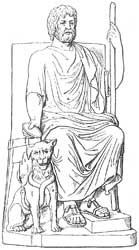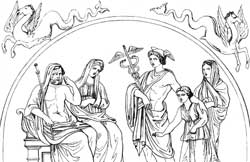Hades
Hades, or Pluto or poetically Aides (Ἀΐδης), Aidoneus (Ἀἵδωνεύς) and Ploutens (Πλουτεν́ς), is the god of the lower world. Plato1 observes that people preferred calling him Pluton (the giver of wealth) to pronouncing the dreaded name of Hades or Aides. Hence we find that in ordinary life and in the mysteries the name Pluton became generally established, while the poets preferred the ancient name Aides or the form Pluteus. The etymology of Hades is uncertain: some derive it from α-ιδεῖν (a-idein), whence it would signify "the god who makes invisible," and others from ἅδω (hadō) or χάδω (chadō); so that Hades would mean "the all-embracer," or "all-receiver." The Roman poets use the names Dis, Orcus, and Tartarus as synonymous with Pluton, for the god of the lower world.
Hades is a son of Cronus and Rhea, and a brother of Zeus and Poseidon. He was married to Persephone, the daughter of Demeter.

In the division of the world among the three brothers, Hades obtained "the darkness of night," the abode of the shades, over which he rules.2 Hence he is called the infernal Zeus (Ζεὺς καταχθόνιος, Zeus katachthonios), or the king of the shades (ἂναε ἐνέρων, anae enerōn).3 As, however, the earth and Olympus belonged to the three brothers in common, he might ascend Olympus, as he did at the time when he was wounded by Heracles.4 But when Hades was in his own kingdom, he was quite unaware of what was going on either on earth or in Olympus,5 and it was only the oaths and curses of men that reached his ears, as they reached those of the Erinyes. He possessed a helmet which rendered the wearer invisible,6 and later traditions stated that this helmet was given him as a present by the Cyclopes after their delivery from Tartarus.7 Ancient story mentions both gods and men who were honored by Hades with the temporary use of this helmet.8
His character is described as fierce and inexorable, whence of all the gods he was most hated by mortals.9 He kept the gates of the lower world closed (whence he is called Πυλάρτης, Pylartes10), that no shade might be able to escape or return to the region of light. When mortals invoked him, they struck the earth with their hands,11 and the sacrifices which were offered to him and Persephone consisted of black male and female sheep, and the person who offered the sacrifice had to turn away his face.12
The ensign of his power was a staff, with which, like Hermes, he drove the shades into the lower world,13 where he had his palace and shared his throne with his consort Persephone. When he carried off Persephone from the upper world, he rode in a golden chariot drawn by four black immortal horses.14 Besides these horses he was also believed to have herds of oxen in the lower world and in the island of Erytheia, which were attended to by Menoetius.15 Like the other gods, he was not a faithful husband; the Furies are called his daughters;16 the nymph Minthe, whom he loved, was metamorphosed by Persephone into the plant called mint,17 and the nymph Leuce, with whom he was likewise in love, was changed by him after her death into a white poplar, and transferred to Elysium.18
Being the king of the lower world, Pluton is the giver of all the blessings that come from the earth: he is the possessor and giver of all the metals contained in the earth, and hence his name Pluton.19 He bears several surnames referring to his ultimately assembling all mortals in his kingdom, and bringing them to rest and peace; such as Polydegmon, Polydectes, Clymenus, Παγκοίτης (Pankoitēs), etc.20

Hades was worshiped throughout Greece and Italy. In Elis he had a sacred enclosure and a temple, which was opened only once in every year;21 and we further know that he had temples at Pylos Triphyliacus, near Mount Menthe, between Tralles and Nysa, at Athens in the grove of the Erinyes, and at Olympia.22 His ordinary attributes are the key of Hades and Cerberus.
In Homer Aides is invariably the name of the god; but in later times it was transferred to his house, his abode or kingdom, so that it became a name for the lower world itself.
❧
Iconography
In ancient art Hades is not frequently portrayed. We possess few representations of this divinity, but in those which still exist, he resembles his brothers Zeus and Poseidon, except that his hair falls down his forehead, and that the majesty of his appearance is dark and gloomy. On vases, gemstones, coins, and sarcophagi he is depicted in a short-sleeved chiton, holding a staff with an eagle or a cornucopia. A mural in the Etruscan grave of Colini near Orvieto shows Hades on a throne next to Persephone. He is wearing a lion's skin with the lion's head as helmet and holding a spear. Later art usually depict him as Pluto in the act of abducting Proserpina, for instance by Bernini and Rembrandt.
References
Notes
- Cratylus, 403.
- Pseudo-Apollodorus. The Library i, 1.5; 2.1.
- Homer. Iliad ix, 457; xx, 61; xv, 187 ff.
- ibid. v, 395; comp. Pausanias. Description of Greece vi, 25.3; Pseudo-Apollodorus. The Library ii, 7.3; Pindar. Olympian Odes, ix, 31.
- Homer. Iliad xx, 61 ff.
- ibid. v, 845.
- Pseudo-Apollodorus. The Library i, 2.1.
- ibid. i, 6.2; ii, 4.2.
- Homer. Iliad ix, 158.
- ibid. viii, 367; comp. Pausanias. Description of Greece v, 20.1; Orphic Hymn 17, 4.
- Iliad ix, 567.
- Odyssey x, 527; Servius on Virgil's Georgics ii, 380.
- Pindar. Olympian Odes, ix, 35.
- Orphic. Argonautica, 1192, Hymns, 17.14; Ovid. Metamorphoses v, 404; Homer. Hymn to Demeter, 19; Claudian. Raptu Proserpinae i, in fin.
- Pseudo-Apollodorus. The Library ii, 5.10-12.
- Servius on Virgil's Aeneid i, 86.
- Strabo. Geography viii, 344; Ovid. Metamorphoses x, 728.
- Servius on Virgil's Eclogues vii, 61.
- Hesiod. Works and Days, 435; Aeschylus. Prometheus Bound, 805; Strabo. Geography iii, 147; Lucian. Timon, 21.
- Homer. Hymn to Demeter, 9; Aeschylus. Prometheus Bound, 153; Sophocles. Antigone, 811; Pausanias. Description of Greece ii, 35.7.
- Pausanias. Description of Greece vi, 25.3.
- Strabo. Geography iii, 344; xiv, 649; Pausanias. Description of Greece i, 28.6; v, 20.1.
Sources
- Aken, Dr. A.R.A. van. (1961). Elseviers Mythologische Encyclopedie. Amsterdam: Elsevier.
- Smith, William. (1870). Dictionary of Greek and Roman Biography and Mythology. London: Taylor, Walton, and Maberly.
This article incorporates text from Dictionary of Greek and Roman Biography and Mythology (1870) by William Smith, which is in the public domain.